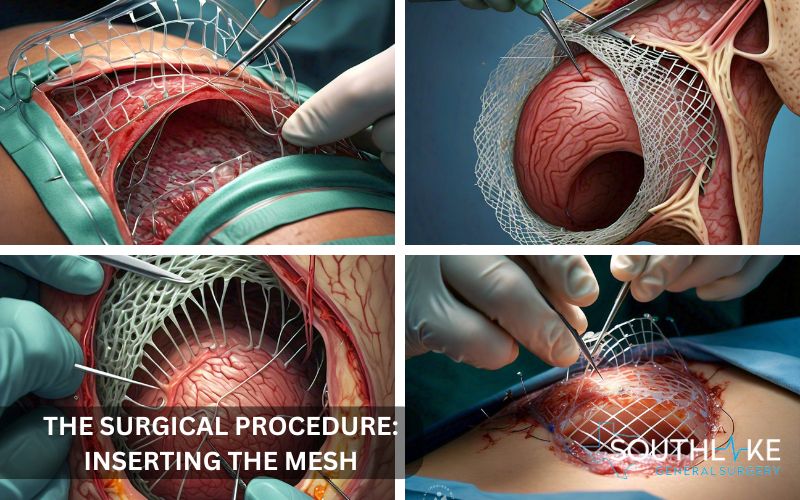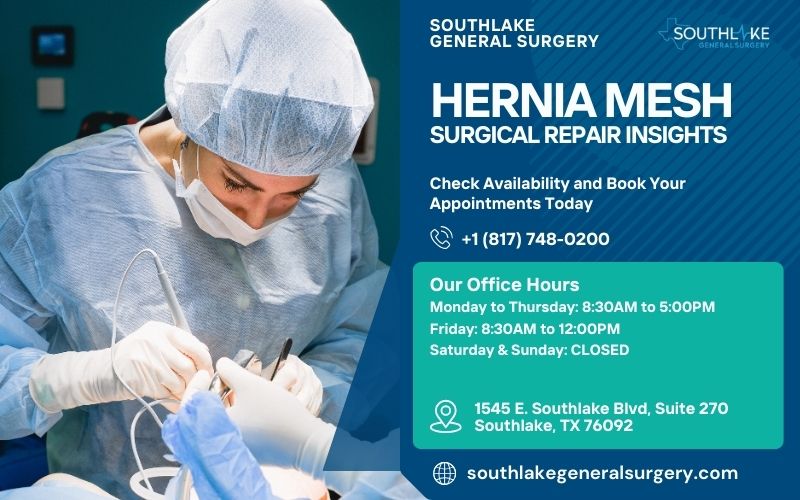Hernia mesh is a sterile, and adaptable substance specifically engineered for the effective repair of hernias. By strengthening weakened tissue, it helps to prevent recurrence and lessen discomfort. A medical breakthrough, hernia mesh reduces risks, quickens healing, and enhances patient results, alleviating suffering for millions across the globe.
Key Highlights
- A hernia mesh is a helpful medical device designed to repair hernias and lower the chance of them recurring.
- This mesh is primarily composed of synthetic materials, providing durable support to the weaker areas of the abdomen.
- There are different types of mesh. Doctors select a treatment based on the type of hernia, its location, and the overall health of the patient.
- While it is usually safe, some individuals might encounter side effects, including infections or discomfort following hernia surgery.
- To achieve the best outcomes, it’s important to learn about your procedure, including its risks and what to expect during recovery.
Understanding a Hernia and the Role of Mesh in Repair Procedure
A hernia occurs when an internal organ or tissue protrudes through a weak area in the muscle or connective tissue. This commonly happens in the abdominal wall. The protrusion can develop, which could cause pain.
Hernia repair surgery is a standard procedure employed to fix a hernia. A hernia mesh can be quite beneficial, it offers additional support to the vulnerable area. This support can help you heal faster and reduce the risk of hernia recurrence.
Defining Hernia: Types and Symptoms

Hernias appear as bumps or swelling on the body. They tend to appear in certain areas of the body. You may encounter a few common types of hernias that are worth knowing about:
Types of Hernias:
- Inguinal Hernia: This is the most prevalent type, and it develops in the groin area
- Umbilical Hernia: Near the belly button, often affecting infants and overweight adults
- Hiatal Hernia: Upper stomach bulges into the chest through the diaphragm
- Incisional Hernia: This type of hernia occurs through a scar resulting from a previous surgery
- Femoral Hernia: Rare, occurring in the upper thigh
Hernia Symptoms:
- You might notice a bulge or lump in the area that’s affected
- Discomfort or pain, especially with coughing, lifting or bending
- Feeling of heaviness or pressure
- Burning sensation or numbness
- Difficulty swallowing (hiatal hernia)
If you think you might have a hernia, it’s a good idea to consult with a qualified medical professional for advice. A doctor can help you make sense of what’s happening. They offer treatment options tailored just for you.
Why Hernia Mesh? Advantages in Surgical Repair

Hernia mesh has transformed the way surgical repairs are done, providing many benefits compared to traditional stitching techniques.
Why Choose Hernia Mesh?
- Lower Recurrence Rates: Using mesh can greatly decrease the chances of hernia recurrence
- Faster Healing: Mesh helps tissue grow, leading to a quicker recovery
- Less Post-Operative Discomfort: The mesh helps to evenly distribute tension, which can lead to less pain
- Stronger Repair: The mesh provides support to weakened areas, ensuring long-lasting durability
- Reduced Complications: Using mesh helps lower the chances of infection and adhesions
Types of Hernia Mesh:
- Synthetic Mesh: Crafted from strong materials like polypropylene
- Biological Mesh: Sourced from natural materials, such as animal tissue
- Composite Mesh: A blend of synthetic and biological materials
- Absorbable Mesh: Gradually dissolves, encouraging the natural growth of tissue
Experience Enhanced Recovery with Hernia Mesh:
For more information on whether hernia mesh is appropriate for you, talk to your doctor. Enjoy:
- Quicker return to normal activities
- Reduced post-operative pain
- Increased peace of mind
Before deciding on a surgical repair, it is important to educate yourself about the advantages of hernia mesh.
The Surgical Procedure: Inserting the Mesh

Hernia mesh surgery is a trusted and efficient way to repair hernias. The procedure is usually done with either general or local anesthesia to keep you comfortable throughout the process.
The procedure typically takes between 30 to 90 minutes, though this can vary depending on the type and complexity of the hernia being treated.
There are two main types of surgery. Laparoscopic surgery involves making small incisions for the procedure. The alternative option is open surgery.
During the procedure, the surgeon meticulously positions the mesh directly over the weakened area of the abdominal wall. They close the incisions with stitches or other methods to keep them secure.
Preparing for Hernia Mesh Surgery
Getting ready for hernia mesh surgery involves both physical and mental preparation, which is really important. This will help ensure that the procedure goes smoothly and successfully.
Pre-Surgery Checklist:
- Consult Your Surgeon: Discuss medical history, allergies and medications
- Medical Clearance: Ensure you obtain approval from your primary care physician
- Lab Tests: You might need to undergo some blood tests, an electrocardiogram, and possibly some imaging tests
- Lifestyle Adjustments:
- Quit smoking
- Limit alcohol consumption
- Maintain a healthy weight
- Medication Management: Inform your surgeon about prescription and over-the-counter medications
Pre-Operative Instructions:
- Fasting: Avoid eating and drinking 8-12 hours before surgery
- Hydration: Stay hydrated until the designated cutoff time
- Transportation: Arrange for a ride home following surgery
- Recovery Support: Make sure you have someone to help you during the first stages of recovery
The Surgery Day: What to Expect
Your hernia surgery day is finally here! Understanding what lies ahead can really boost your comfort and readiness.
Arrival and Preparation:
Upon arrival, you’ll:
- Check in at the designated medical facility or surgical center for your appointment
- Complete any remaining paperwork
- Meet with your surgical team
- Change into a hospital gown
Pre-Surgery Routine:
- Vital Sign Check: Monitoring of blood pressure, temperature, and heart rate
- IV Insertion: Essential for the administration of anesthesia and medications
- Anesthesia Discussion: Evaluating choices with your anesthesiologist
- Preparation of the Surgical Site: Ensuring the incision area is properly cleaned and ready for the procedure
Your hospital stay typically involves either outpatient care or just one night, depending on the type of surgery you underwent and your recovery progress.
Post-Surgical Care and Recovery

After hernia surgery, taking care of yourself and focusing on recovery is essential for the best healing outcomes. To assist you in achieving a successful and smooth recovery, the following are some useful tips.
Immediate Aftercare Following Surgery (1-3 days)
In the initial days following hernia mesh surgery, it’s quite common to experience some discomfort. It’s possible that you might notice some swelling or bruising around the incision area. Your doctor’s pain medicine can be really helpful in easing this discomfort.
- Take a rest and refrain from stretching, bending, or lifting heavy objects.
- Manage pain with medication as directed
- Monitor surgical site for signs of infection (redness, swelling, discharge)
- Hydrate yourself with water and other clear fluids
- Gradually increase mobility to prevent blood clots
Short-Term Recovery (1-2 weeks)
The initial two weeks following hernia surgery are really important for ensuring the best healing possible. Take this time to prioritize rest, recovery, and careful management of your body.
- Follow wound care instructions
- Take medications as prescribed
- Attend follow-up appointments with your surgeon
- Avoid driving, heavy lifting or engaging in strenuous activities
- Return to work/school when cleared by your surgeon
Long-Term Recovery: Tips and Expectations
The long-term recovery after hernia surgery usually lasts between 2 to 6 months. Here’s what you can look forward to and some helpful tips for optimal healing.
Physical Progression:
- Raise the intensity and duration of exercise gradually.
- Strengthen your core muscles with gentle exercises such as yoga and Pilates
- In the first couple of months, it’s best to avoid bending over or lifting anything heavy to ensure a smooth recovery
- Resume intense activities or sports only after receiving clearance from your surgeon
Lifestyle Adjustments:
- Ensure a balanced diet rich in fiber, vitamins, and minerals
- Stay hydrated to prevent constipation
- Reduce stress with meditation and deep breathing
- For a speedy recovery, make sure you get enough sleep (7-8 hours)
Mesh Integration:
- Allow a duration of 2-3 months for the complete integration of the mesh with the surrounding tissue
- Refrain from engaging in activities that could potentially displace or jeopardize the integrity of the mesh
- Follow the mesh care instructions from your surgeon
Monitoring and Follow-Up:
- Schedule follow-up appointments with your surgeon at regular intervals
- If you notice any unusual symptoms or have any concerns, don’t hesitate to get in touch with your surgeon
- Make sure to attend your follow-up appointments to evaluate the mesh and get any sutures or staples removed
Expected Timeline:
- 2-3 months: Return to moderate activities
- 3-6 months: You’ll be back to full recovery and ready to engage in strenuous activities!
- 6-12 months: Mesh fully integrated with surrounding tissue
By getting a clear picture of what to expect during long-term recovery and embracing healthy habits, you’ll enhance your healing journey and reduce the chances of any complications.
Potential Complications and Solutions
Hernia mesh is usually considered safe and is often effective in its use. However, it’s important to remember that issues can arise, just as with any surgical procedure. Some of the issues that can arise include infections, fluid accumulation referred to as seromas, scar tissue called adhesions, or pain.
Recognizing issues early and seeking medical assistance promptly is crucial. A variety of issues can often be managed with medication or basic remedies. Sometimes, surgery may be necessary to remove the mesh.
Recognizing Signs of Complications
After hernia mesh surgery, it’s important to watch for any possible concerns that may arise. If you see any of the following signs, it’s beneficial to contact your surgeon as soon as possible:
- Redness or increased pain at the location of the incision
- Fever or chills
- Nausea, vomiting, or constipation
- Trouble urinating
- Swelling at the hernia site
- Fluid coming from the incision
Letting your doctor know about these symptoms as soon as possible can really help avoid more serious problems down the line.
Addressing Mesh-Related Concerns
A thorough evaluation of your situation will be performed by your physician if you are experiencing issues with hernia mesh. They will explain all of your available options and help you choose the best one.
The treatment you need can differ depending on how severe your issue is. Here are a few options to consider: you might need medication such as antibiotics to address infections, simple procedures to help drain any excess fluid, or possibly surgery to remove the mesh.
It’s critical to communicate honestly with your physician. Let them know how you’re feeling. Talk about your needs and explore what options might suit you best!
Conclusion
Hernia mesh surgery is a dependable and effective method for repairing hernias. When you take the time to learn about the procedure, preparation, and recovery, you gain the confidence to make well-informed choices.
Some great advantages are fewer complications, quicker recovery times, and an improved quality of life. It’s an excellent option to talk to your surgeon, keep yourself updated, and make self-care a top priority! Empower yourself to manage your health by scheduling a consultation!
Enjoy a life free from hernias, where you can experience enhanced physical comfort, better mental well-being, and a boost in energy levels. Wishing you all the best as you embark on your journey to achieving optimal health!
Make an Appointment
Are you noticing any symptoms of a hernia or feeling worried about it coming back? Schedule your appointment with Dr. Valeria Simone, MD, at Southlake General Surgery in Texas, USA. Dr. Simone, a well-respected hernia repair specialist, provides:
- Specialization in general surgery
- Expertise in mesh removal and surgical mesh
- Customized treatment plans tailored to address individual needs
- Guidance on different types of hernias and how they can be treated
- Effective strategies to reduce the chances of recurrence and manage chronic pain risks
Contact our healthcare expert today at +1 (817) 748-0200 to schedule your consultation. Experience compassionate care, advanced surgical techniques, and tailored solutions.
Frequently Asked Questions
How long does the hernia mesh last?
Hernia mesh is typically crafted from durable synthetic materials. In the United States, this mesh is crafted to serve as a durable implant. This product is designed to last a lifetime.
Can hernia mesh cause pain years later?
Some people experience long-term chronic pain due to hernia mesh. This discomfort can happen for a variety of reasons. It might be connected to the mesh contracting, which could cause some nerve irritation, or it could be a result of swelling.
What are the signs of mesh failure?
If the mesh isn’t working properly, you might notice symptoms that resemble a hernia returning. You may notice some signs that indicate a bulge at the surgery site. It’s possible that you might experience some discomfort, pain, or a sensation of pulling.
Is mesh removal possible if complications arise?
Absolutely, if there are any issues, mesh removal is an option that can be considered. This surgery can be quite complex. A complete check-up by a doctor should be the first step before proceeding. It’s essential for them to consider the risks and benefits.
Can I recover smoothly from hernia mesh surgery?
Yes, a smooth recovery can be achieved after hernia mesh surgery. By following post-operative instructions, getting enough rest, and attending follow-up appointments, you can help reduce complications. This method allows many patients to get back to their usual activities in approximately 2 to 6 weeks.
Medically Reviewed By: Dr. Valeria Simone MD
Board-certified General Surgeon at Southlake General Surgery, Texas, USA.
Follow us on Facebook and YouTube.
References:
- Bilsel, Y., & Abci, I. (2012). The search for ideal hernia repair; mesh materials and types. International Journal of Surgery, 10(6), 317–321. https://doi.org/10.1016/j.ijsu.2012.05.002
- Hernia: MedlinePlus Medical Encyclopedia. (n.d.). https://medlineplus.gov/ency/article/000960.htm
- See, C. W., Kim, T., & Zhu, D. (2020). Hernia Mesh and Hernia Repair: A Review. Engineered Regeneration, 1, 19–33. https://doi.org/10.1016/j.engreg.2020.05.002
- Elhage, S. A., Thielen, O. N., Otero, J., Huber, A. T., Grigg, T. M., Suddreth, C. E., Monjimbo, G. A., Prasad, T., Augenstein, V. A., & Heniford, B. T. (2021). Perceptions and understanding about mesh and hernia surgery: What do patients really think? Surgery, 169(6), 1400–1406. https://doi.org/10.1016/j.surg.2020.12.001

